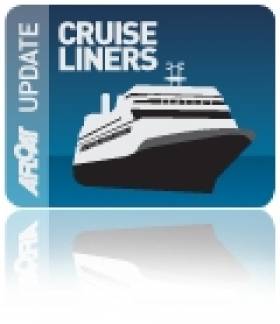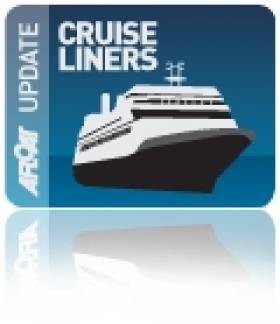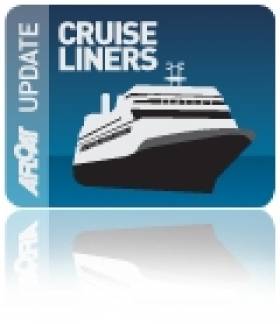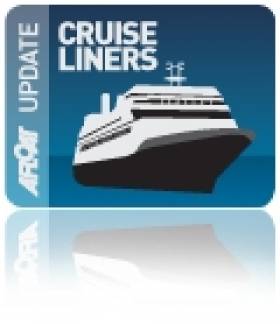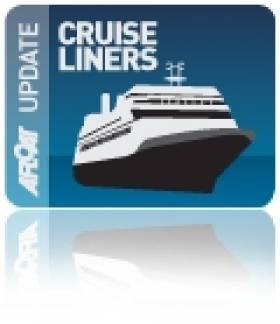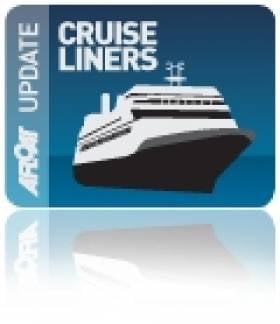Displaying items by tag: Queen Mary 2
Queen Mary 2 kicks off the 2013 cruise liner season in Dun Laoghaire, Dublin early on Thursday, May 16 and she'll be visible off the Kish lighthouse at the entrance to Dublin Bay from before 6am onher journey from Greenock in Scotland.
The 151,400 tonnes giant vessel will make her way to the southside of the bay before anchoring in Scotsman's Bay, Sandycove for the day, approximately 1.8 nautical miles to the north east of Dun Laoghaire's East Pier.
Her passengers are mostly German with the cruise originating in Hamburg, the recent venue for the world's biggest port festival.
The liner will be at anchor in the bay all day on Thursday, departing at 17.30 and heading for Holyhead, on the far side of the Irish Sea.
Click for more on Queen Mary 2 ship and her visit to Dun Laoghaire
#LinerQueenMary2- The eagerly awaited visit of the world's only 'liner', Cunard Line's flagship Queen Mary 2 is now just over a week away to making her first ever visit to Dublin Bay with an 'anchorage' call off Dun Laoghaire Harbour, writes Jehan Ashmore. The liner arrives next Thursday, May 16th.
The significance of the call of Queen Mary 2 or 'QM2' as she is affectionately known will no doubt generate a major draw for onlookers when she arrives on the Dublin Bay horizon from a northerly direction around 06.00hrs.
Vantage points lining the East Pier, Scotsman's Bay and beyond will be condusive to witness the sheer size of the 151,400 tonnes giant vessel as she looms towards Dun Laoghaire.
The French built liner which cost €659m (US$800 million) is currently on a trans-Atlantic voyage and is bound for her homeport of Southampton. The liner represents a link to the past of the bygone era in travelling the Atlantic in complete luxury while capturing the essence of the classic sailing voyage experience to and from New York.
Facilities are both elegant and grand and where her 2,600 passengers have no less than 14 spacious decks with all the luxury one would expect with such liner prestige and historical pedigree.
Among the amenities guests can enjoy the Canyon Ranch spa-club, the only planetarium at sea and a 3D cinema.
Queen Mary 2 will be the highlight for the Dun Laoghaire Harbour Company as the passenger liner also marks the opening of the 2013 cruise season, and where such a large vessel will provide a much needed boost to regional tourism.
The port can also look forward to a dramatic increase this season as a further dozen or so cruise calls are scheduled to bring 30,000 passengers and crew to the port, a stark contrast to last year's return to this business sector with just two calls.
Another first will be the use of the purpose built cruise liner dock pontoon, when the QM2's tenders are expected to berth at the facility in the Coal Harbour.
The QM2's predecessor of only half her size the 70,000 tonnes Queen Elizabeth II (QE2) had made two anchorage calls offshore of Dun Laoghaire Harbour as did some other well known large cruiseships more than a decade ago.
In regards to Queen Mary 2, this will be her third call to Irish waters and as with the first visit, she too made an anchorage call offshore of Dunmore East in 2005. On her second call to Cobh in 2011 this involved berthing alongside the quay.
Cruise Callers to Dun Laoghaire ‘Recalled’
#DUN LAOGHAIRE CRUISELINERS – The recent call of what is believed to be the world's smallest cruiseship the Quest (1991/1,180grt) to Dun Laoghaire Harbour as part of an initiative to develop this sector is by no means completely new to the harbour, writes Jehan Ashmore.
It was not until a decade ago that the last cruise callers were on the scene, albeit making infrequent visits and they also varied considerably in size. Among the callers was the famous 'Cunarder' Queen Elizabeth 2 or 'QE2', RCCL's Norway formerly French Line's France and Celebrity Cruise then brand new Constellation. Notably these large vessels all made anchorage calls in Dublin Bay.
Constellation made this call in 2002 as did the Sun Bay II which was also then recently launched into service and the cruiseships were making their debut season in European waters. They could not be so different, the 2,800 tonnes Sun Bay II with an 89 passenger capacity in complete contrast to the 90,000 tonnes Constellation with over 1,800 passengers.
The diminutive Sun Bay II was not too dissimilar to Noble Caledonia's Quest in terms of passenger capacity being slightly smaller with a capacity of 52. She was alongside Carlisle Pier where her guests were on a 9-night Garden themed cruise of UK and Ireland that included tours to Powerscourt and Mount Usher in Co. Wicklow.
On the call of Constellation she anchored relatively closer to the shore off Bulloch Harbour, compared to QE2 and Norway's calls and she presented an imposing and impressive sight.
In the case of the Norway, her passengers were ferried to the marina by unusually large tenders more akin to tank landing craft as they bow doors (click PHOTO). In fact they were so large that they could not be stowed on the lifeboat deck and instead located forward of the bridge where deck-mounted cranes were used for hoisting operations.
The practice of anchorage calls will continue as vessels of this size will remain too large to be accommodated in the harbour in the short term, though the Dun Laoghaire Harbour Company's 'masterplan' includes a proposed €18m new cruise terminal. They claim the terminal would be capable of handling the largest and most modern cruiseships in the world.
In the meantime the landing point for tenders to use a new tender dock facility was installed recently at the Traders Wharf, as distinct to the Carlisle Pier (site of proposed Diaspora Museum) where small to medium sized vessels are to berth.
A further three more calls are scheduled this season, including a return call next week of Quest and other vessels capable of carrying around 500 passengers. This figure is to rise considerably in May 2013, thanks mostly due in part to the massive Cunard Line flagship Queen Mary 2 (QM2). The 151,400 tonnes 'liner' can take over 2,600 passengers and 1,200 crew alone.
With the visit of QM2, this is to be her fist call to Dublin Bay, as she is still to be big even for Dublin Port to handle. Likewise the rivals across Dublin Bay in the Dublin Port Company are proposing as part of their masterplan to build a €30m dedicated cruise terminal. This facility would also be able to accommodate very large cruise callers.
It will be interesting to see how both completing ports progress and how they market themselves to the cruise sector industry, no doubt across the board. The giant ships look after large volumes which keep cruise prices down. As for the smaller boutique style of cruiseship operators, they can command higher prices by targeting the top end of the market and where they have higher-spending power at ports of call . The cruise industry overall is becoming increasingly more globalised where it was traditionally the preserve of the European and North American markets.
Arguably it is debatable if there should be two cruise terminals built as it reminiscent of the controversary during the '80's over the battle between which Dublin Bay port would be chosen for the site of a new single dedicated multi-user car-ferry terminal.
As it transpired the ferry service to Holyhead remains operating out of Dun Laoghaire Harbour, where a new terminal was built specifically to dock the revolutionary design of the HSS (High-speed Sea Service) fast craft catamaran car-ferry. Albeit in recent years the route's sailing frequency has reduced considerably. Under the last contract between Stena and the harbour company, this has led to considerably less revenue generated in harbour dues. The HSS Stena Explorer currently maintains only a single daily round-trip and only on a seasonal basis between April-September.
While at Dublin Port a multi-user ferry terminal was built but Stena Line did not immediately become part of the facility. It was not until 1995 that they set up an additional new service from Dublin Port to Holyhead. They use a second adjacent terminal that is currently served by two ferries on the company's second route to Wales.
#CRUISELINERS – The Quest (1992/1,180grt) an ice-strengthened expedition cruiseship, will have the distinction of being the first cruise caller to Dun Laoghaire Harbour in many years. The cruise call next week (24th April) will mark a new era in attracting the cruise sector as part of the harbour's masterplan launched last year, writes Jehan Ashmore.
The Quest will have a German clientele of around 50 passengers, though other larger capacity vessels are scheduled for the summer in this first phase of cruise callers. The cruise sector season is seen to be a significant economic boost to the local economy considering the reduced ferry side of the harbour business in recent years.
Passengers on the Noble Caledonia operated vessel are to take a 9-night 'Garden' Cruise with prices starting from £3,295. She is to set sail from Oban Scotland, then to Ireland, Wales, Cornwall, the Isles of Scilly and Channel Islands.
On her Dun Laoghaire call passengers will head for Powerscourt and nearby Mount Usher gardens in Co. Wicklow. On the second Irish port of call to Waterford as previously reported, they will visit the privately owned Mount Congreve Gardens on the banks of the River Suir.
Notably scheduled in for next year's season is the 'flagship' of the Cunard Line fleet, the 2,620 passenger liner Queen Mary 2, all of 151,400 gross tonnes. She is to make an anchorage call in May 2013, according to Captain Frank Allan, Dun Laoghaire Harbourmaster.
As part of the programme to attract and develop Dun Laoghaire as a cruise call port of call, a new tender docking facility was recently completed. The facility is designed to cater for large cruiseships using the harbour as it will cater for easier access by boats tendering passengers to vessels such as Queen Mary 2 during anchorage calls out in Dublin Bay.
The new tender facility will also benefit the public as the facility can be used for training purposes and for the operation of boat tours around Dublin Bay and trips out to Dalkey Island.
- Dun Laoghaire Harbour
- Cruise Liners
- Irish cruise calls
- Noble Caledonia
- MVQuest
- Cunard Line
- Queen Mary 2
- QM2
- Dun Laoghaire Harbour Company
- Dublin Bay
- Dublin Bay anchorage cruise calls
- Dalkey Island
- Powerscourt Gardens
- Mount Congreve Gardens Waterford
- River Suir
- Dun Laoghaire Harbour Masterplan
- Dublin Bay News
Dublin Port Turn-Around Offers Direct Cruises to the Sun
With a short-turn around in port, more cruise-goers will be boarding for a mid-afternoon departure, marking the start of a 13-night Canary Islands & Madeira cruise. When she heads out of the port, the first port of call is Falmouth then it's off to Leixoes (Portugal), Agadir (Morocco), Arrecife (Lanzarote), Las Palmas (Gran Canaria), Funchal (Madeira), Lisbon (Portugal) and Vigo (Spain) before returning to Dublin.
The vessels final end-of season cruise from Dublin is on 25 October, with a 10-night cruise to Nice (returning by air). The interim ports of call are to Falmouth, Leixoes, Lisbon, Cartagena (Spain) Palma and Mahon (Menorca). To read more about this cruise click HERE.
In addition to Dublin calls the former Cunard Countess, also called this season to Cork Harbour. It was during a call last month to Ringaskiddy that another 'Cunarder' the flagship, Queen Mary 2 was also in port on a call to Cobh. To read more of that visit click HERE.
Rugby World Cup Coverage for Fans on Cruise-Ships
A total of 24 matches are being shown, starting from the opening game and will include all four Home Nations' matches, quarter-finals, semi -finals, bronze final and then the final on 23rd October. Of course there will be other fans on board from Wales, Scotland, England and elsewhere watching the fixtures throughout the cruise-ships various sporting bars, pubs and other venues.
Carnival Corporation's UK entertainment services general manager, Paul Wright, said: "The Rugby World Cup is of great interest to many of our passengers and we're pleased that nobody will miss out by being on holiday with us throughout this time. At any one time we could have more than 19,000 passengers collectively on board and rooting for one of the Four Nations to bring home the trophy".
He added: "Most people have a sport that they follow and some times, like on a cruise ship, you won't have access to your favourite sport, which means a lot to fans. On our last cruise on Independence of the Seas, we had popular sports shown in state rooms and certain bars around the ship, of course football was the most common sport shown".
Incidentally Independence of the Seas has also called to Cobh since her Irish debut in 2007 and at 154,407 tonnes is the largest ever cruise-caller to Cork Harbour. She surpasses Cunard Line's flagship Queen Mary 2 of 148,528 tonnes which too berthed at Cobh last Wednesday, four days after Queen Elizabeth's inaugural visit.
Cunard Line Flagship Queen Mary 2 Calls to Cobh
The current liner (QM2) can carry 2,620 passengers and a crew of over 1,200 on a vessel is the longest, tallest and widest of any passenger liner built. The luxury liner has private balconies for nearly 80 per cent of cabins and has an art collection worth £3.5m. To complement these works of art there is the first 'floating planetarium', the largest library at sea, boasting 8,000 hardbacks and also the largest ballroom to grace a ship on the oceans.
Queen Mary 2 was short-listed to be built in Belfast at the Harland & Wolff shipyard, but the contract went to Chantiers d'Atlantique, St. Nazaire on the west coast of France.
Her first visit to Irish waters occurred when she anchored off Dunmore East in 2005, the liner had arrived overnight on a passage from her homeport of Southampton and was on a nine-day cruise of British, Irish and Baltic state ports.
Today's Cobh visit of the 345m long Queen Mary 2 coincided with Ocean Countess, a former 'Cunarder', which is also in the port. The 163m vessel was built in 1976 and launched as their Cunard Countess. She weighs 17,593grt and has a 800 passenger capacity. Last year she joined Cruise & Maritime Voyages (CMV) fleet under charter from Majestic International Cruises Group.
Also at work in Cork Harbour was the excursion vessel Spirit of the Isles which apart from operating River Lee sight-seeing cruises between Cork city-centre and Cobh at the weekends, is running a charter cruise this afternoon to Spike Island. For information about sightseeing trips and chartering click HERE.
Queen’s Namesake to Retrace Royal Visit
The 90,901 gross registered tonnes cruise ship is to depart her Hampshire homeport, where she is to similarly follow the monarch in that she is scheduled to make a port of call to Dublin first on 9 September and make a call to Cork afterwards.
With a length of 295m / 965-feet the vessel will dock in the centre of the capital port before she sails overnight to make a morning arrival at Cobh, the dedicated cruise terminal for the Port of Cork. She is scheduled to stay at the Cork Harbour town formerly named Queenstown until a 17.00 hour departure.
Her visit coincides with Cork Harbour Open Day, where visitors can view the impressive vessel from the quayside, for more details visit www.corkharbour.ie
Incidentally her near-sister Queen Victoria also called to Dublin in May and the remaining vessel of the Cunard fleet, the 'flagship' liner Queen Mary 2 is also to dock in Cobh three days later after Queen Elisabeth's visit.
- Cobh
- Cork Harbour
- port of Cork
- Cruise Liners
- Cork Harbour Open Day
- Ports and Shipping
- Cobh Cruise Terminal
- Queen Elizabeth II
- Cork Harbour News
- Port of Cork Company
- Cunard Line
- queen victoria
- Port of Cork News
- Queen Elizabeth
- Queen Mary 2
- QM2
- Cruise Liner news
- TransAtlantic Liners
- Cruise ships
- Irish cruiseship calls
- Queen's visit to Ireland
- QV
- QE
- Cunarders
- Cobh Cunarders
- Cobh cruise calls
- Cunard liners
- Cunard cruiseships
- Royal visit to Ireland
- Cobh cruise liners list
Cork's Cruiseship's Call Schedule 2011
The inaugural call for this season was made last Monday by Cunard Line's Queen Victoria (90,049grt) and the four year-old vessel is to return for another visit on 5 May. Her slighty larger sister Queen Elizabeth (90,400grt) will make her maiden 'Irish' port of call on 10 September.
Last Autumn the 2,092 passenger cruiseship newbuild was 'floated-out' of the building dry-dock at Fincantieri's Monfalcone shipyard in Italy. At 294m long her hull is derived from the 'Vista' class series built for Carnival Corporation, owners of the Cunard Line.
Four days later the Cunard 'flagship' Queen Mary 2 (QM2) will also make an appearance. The 148,528grt French built vessel is the only designated cruise-liner in the world, the title was handed on from her predecessor, Queen Elizabeth II (QE2).
Throughout the career of the iconic liner, she made several calls to Cork (Ringaskiddy) while employed on the Atlantic 'liner' service between Southampton and New York.
On her farewell cruise QE2 made her first and only call to Cobh in 2008, the 70,327grt ship was meant to stay for a standard day-long visit but due to strong windy weather conditions in Cherbourg, she was prevented from docking and spent an un-scheduled overnight stay in the picturesque location.
The scheduling of all three 'Cunarders' to Cobh will be a first for the Port of Cork. Asides the Italian-built trio, there will be plenty more cruise callers lined up for the season, notably the Independence of the Seas, the largest cruiseship caller to an Irish port.
The Finnish built giant weighs 154,407 grt (some 6,000 tonnes larger than the liner QM2) and can carry 4,375 passengers.
Another large visitor will be the Azura at 115,055grt which can handle 3,100 passengers. She is the built to a design based from the 'Grand' class ships commissioned for Carnival Corporation's which also owns Princess Cruises.
The value of the cruiseship sector business to the island of Ireland this year is valued at €60m. The list below is a schedule of cruiseship calls to Cork Harbour (Cobh, Ringaskiddy and Cork city-centre quays).
Please note information is based in the order of ship's name first, passenger capacity (PAX), arrival date (time), location of berth and lastly departure date (time). For the most up-to-date information please refer to the Port of Cork Company website cruise call list.
ATHENA 580 Apr 27th at 08:00 Cobh Cruise Terminal
CELEBRITY ECLIPSE 3129 Apr 30th at 14:00 Cobh Cruise Terminal
May 1st at 16:00
INDEPENDENCE OF THE SEAS 4375 May 1st at 17:00 Cobh Cruise Terminal
May 2nd at 18:00
CELEBRITY ECLIPSE 3129 May 4th at 14:00 Cobh Cruise Terminal
DISCOVERY 689 May 4th at 07:00 Ringaskiddy DWB May 4th at 22:00
QUEEN VICTORIA 2000 May 5th at 20:02 Cobh Cruise Terminal
May 25th at 18:00
EMERALD PRINCESS 3592 May 6th at 08:00 Cobh Cruise Terminal
May 6th at 19:00
LE BOREAL 260 May 9th at 07:00 Cobh Cruise Terminal May 9th at 17:00
GRAND PRINCESS 3300 May 15th at 06:00 Cobh Cruise Terminal
May 15th at 17:00
COSTA DELIZIOSA 2826 May 17th at 07:00 Cobh Cruise Terminal
May 17th at 19:00
CROWN PRINCESS 3114 May 24th at 07:00 Cobh Cruise Terminal
May 24th at 17:00
ROTTERDAM 1668 May 26th at 07:00 Cobh Cruise Terminal
May 26th at 17:00
SILVER WHISPER 1668 May 28th at 09:00 Cobh Cruise Terminal
May 28th at 23:00
LE DIAMANT 200 Jun 22nd at 06:00 Cobh Cruise Terminal
Jun 22nd at 19:00
ASTOR 656 Jun 27th at 06:00 Ringaskiddy DWB
SILVER CLOUD 296 Jun 27th at 07:00 Cobh Cruise Terminal
Jun 27th at 19:00
MINERVA 352 Jul 1st at 07:00 Cobh Cruise Terminal
LE DIAMANT 200 Jul 7th at 06:00 North Custom House Quay
Jul 7th at 23:30
AURORA 1950 Jul 7th at 11:30 Cobh Cruise Terminal
Jul 7th at 23:00
ATHENA 580 Jul 15th at 08:00 Cobh Cruise Terminal
Jul 15th at 17:00
SILVER CLOUD 296 Jul 18th at 07:00 Cobh Cruise Terminal
Jul 18th at 19:00
SPIRIT OF ADVENTURE 470 Jul 19th at 06:00 North Custom House Quay
Jul 19th at 18:00
ROTTERDAM 1668 Jul 19th at 07:00 Cobh Cruise Terminal
Jul 19th at 17:00
AZURA 3100 Jul 19th at 08:00 Ringaskiddy DWB
Jul 19th at 18:00
DAWN PRINCESS 2342 Jul 24th at 06:00 Cobh Cruise Terminal
Jul 24th at 17:00
CROWN PRINCESS 3114 Jul 26th at 07:00 Cobh Cruise Terminal
Jul 26th at 17:00
MARINA- Jul 27th at 07:00 Cobh Cruise Terminal
Jul 27th at 18:00
AIDABLU 2580 Aug 11th at 07:00 Cobh Cruise Terminal
Aug 11th at 18:00
MAASDAM 1613 Aug 13th at 06:00 Cobh Cruise Terminal
Aug 13th at 15:00
SEVEN SEAS VOYAGER 730 Aug 17th at 07:00 Cobh Cruise Terminal
Aug 17th at 15:00
CROWN PRINCESS 3114 Aug 18th at 07:00 Cobh Cruise Terminal
Aug 18th at 17:00
LE DIAMANT 200 Aug 19th at 06:00 Cobh Cruise Terminal
Aug 19th at 23:30
CLIPPER ODYSSEY 128 Aug 19th at 07:00 Cobh Cruise Terminal
Aug 19th at 21:00
ATHENA 580 Aug 22nd at 07:30 Cobh Cruise Terminal
Aug 22nd at 17:00
AIDABLU 2580 Aug 25th at 07:00 Cobh Cruise Terminal
Aug 25th at 18:00
LE DIAMANT 200 Aug 26th at 06:00 Cobh Cruise Terminal
Aug 26th at 23:00
ARCADIA 2388 Aug 29th at 07:00 Cobh Cruise Terminal
Aug 29th at 17:00
AZAMARA JOURNEY 702 Aug 31st at 08:00 Cobh Cruise Terminal
COSTA DELIZIOSA 2826 Sep 1st at 07:00 Cobh Cruise Terminal
Sep 1st at 18:00
LE DIAMANT 200 Sep 3rd at 07:00 North Custom House Quay
Sep 3rd at 17:00
PRINSENDAM 843 Sep 3rd at 09:00 Cobh Cruise Terminal
Sep 3rd at 18:00
DISCOVERY 689 Sep 4th at 08:00 Cobh Cruise Terminal
Sep 4th at 18:00
SILVER CLOUD 296 Sep 5th at 07:00 Cobh Cruise Terminal
Sep 5th at 18:00
JEWEL OF THE SEAS 2500 Sep 6th at 08:00 Cobh Cruise Terminal
Sep 6th at 16:00
SILVER WHISPER 388 Sep 10th at 06:00 Cobh Cruise Terminal
Sep 10th at 18:00
QUEEN ELIZABETH 2092 Sep 10th at 08:00 Ringaskiddy DWB
Sep 10th at 17:00
OCEAN COUNTESS 884 Sep 14th at 06:30 Ringaskiddy DWB
Sep 14th at 16:30
QUEEN MARY 2 2592 Sep 14th at 08:00 Cobh Cruise Terminal
Sep 14th at 17:00
OCEAN COUNTESS 884 Sep 16th at 07:30 Cobh Cruise Terminal
FRAM 500 Sep 28th at 07:00 Cobh Cruise Terminal
Sep 28th at 18:00
SAGA RUBY 668 Dec 15th at 07:00 Cobh Cruise Terminal
Dec 15th at 23:00
- Cruiseships
- Cruise Liners
- Cork Harbour
- Cork Harbour News
- Port of Cork Company
- Port of Cork News
- Cobh
- Cobh Cruise Terminal
- Cunard Line
- Carnival Corporation
- Princess Cruises
- queen victoria
- Queen Elizabeth
- Queen Elizabeth II
- QE2
- Queen Mary 2
- QM2
- Independence of the Seas
- Royal Carribean Cruise Line
- RCCL
- Fincantieri
- Grandclass
- Vistaclass
- Ports and Shipping News





























